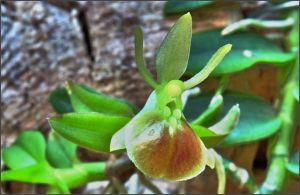No edit summary |
No edit summary |
||
| Line 1: | Line 1: | ||
[[File:Epidendrum_peperomia.jpg|thumb|Epidendrum peperomia (not my photo)]] | [[File:Epidendrum_peperomia.jpg|thumb|''Epidendrum peperomia'' (not my photo)]] | ||
'''Common Names:''' The Peperomia-Like Epidendrum<br /> | '''Common Names:''' The Peperomia-Like Epidendrum<br /> | ||
| Line 7: | Line 7: | ||
'''Blooms:''' winter, spring, summer and autumn<br /> | '''Blooms:''' winter, spring, summer and autumn<br /> | ||
'''Flower Size:''' 2.5cm<br /> | '''Flower Size:''' 2.5cm<br /> | ||
'''Synonyms:''' | '''Synonyms:''' ''Epidendrum gnomus'' Schlechter 1921; ''Epidendrum lambeauanum'' De Wild. 1904; ''Epidendrum matthewsii'' Rchb.f 1876; ''Epidendrum porpax'' Rchb.f 1855; ''Epidendrum porphyrophyllum'' Schlechter 1922; ''Nanodes gnomus'' (Schltr.) Brieger 1977; ''Nanodes matthewsii'' [Rchb.f] Rolfe 1892; ''Nanodes porpax'' (Rchb. f.) Brieger 1960; ''Nanodes porpax'' (Rchb. f.) Brieger & Lückel 1978; ''Neolehmannia mathewsii'' (Rchb. f.) Garay 1977; ''Neolehmannia peperomia'' (Rchb. f.) Garay & Dunst. 1976; ''Neolehmannia porpax'' [Rchb.f] Garay & Dunsterville 1976 | ||
Found from Mexico, Guatemala, Honduras, Nicaragua, Costa Rica, Panama, Colombia, Venezuela, Ecuador, Peru, Bolivia and Brazil in pine and oak forests at altitudes of 600 to 2700 metres as a dwarf, epiphytic, warm to cool growing, reed-stem herb which forms large mats of clustered leafy stems carrying coriaceous-fleshy, distichous, oblong, obtuse or emarginate leaves that can bloom at any time with large, one to a few flowers on a terminal inflorescence emerging from between the apical leaves and subtended by bracts. This species has no pseudobulbs, instead it is a stem growing to 8cm long with a series of alternating, succulent leaves suffused with pearl if given bright light. Can be mounted on treefern or in a suspended pot with a coarse mix to allow the roots to get air. It can then grow out and over the edge of the pot and makes an impressive display when blooming. Grow warm to cool with bright light to partial full sun, ample water while growing and misting through the winter instead of a watering. | Found from Mexico, Guatemala, Honduras, Nicaragua, Costa Rica, Panama, Colombia, Venezuela, Ecuador, Peru, Bolivia and Brazil in pine and oak forests at altitudes of 600 to 2700 metres as a dwarf, epiphytic, warm to cool growing, reed-stem herb which forms large mats of clustered leafy stems carrying coriaceous-fleshy, distichous, oblong, obtuse or emarginate leaves that can bloom at any time with large, one to a few flowers on a terminal inflorescence emerging from between the apical leaves and subtended by bracts. This species has no pseudobulbs, instead it is a stem growing to 8cm long with a series of alternating, succulent leaves suffused with pearl if given bright light. Can be mounted on treefern or in a suspended pot with a coarse mix to allow the roots to get air. It can then grow out and over the edge of the pot and makes an impressive display when blooming. Grow warm to cool with bright light to partial full sun, ample water while growing and misting through the winter instead of a watering. | ||
| Line 25: | Line 25: | ||
-14.235004, -51.925280, Brazil | -14.235004, -51.925280, Brazil | ||
</googlemap> | </googlemap> | ||
{{ | |||
#display_points: | |||
service=googlemaps3 | |||
|address=Mexico~Mexico; Guatemala~Guatemala; Honduras~Honduras; Nicaragua~Nicaragua; Costa Rica~Costa Rica; Panama~Panama; Colombia~Colombia; Venezuela~Venezuela; Ecuador~Ecuador; Peru~Peru; Bolivia~Bolivia; Brazil~Brazil | |||
|type=terrain | |||
|types=satellite,terrain | |||
|height=350 | |||
|width=550 | |||
|autozoom=off | |||
|controls=type | |||
}} | |||
Revision as of 22:30, 12 May 2010

Common Names: The Peperomia-Like Epidendrum
Scented: no
Light Requirements: deep shade
Temperature Requirements: cool to hot
Blooms: winter, spring, summer and autumn
Flower Size: 2.5cm
Synonyms: Epidendrum gnomus Schlechter 1921; Epidendrum lambeauanum De Wild. 1904; Epidendrum matthewsii Rchb.f 1876; Epidendrum porpax Rchb.f 1855; Epidendrum porphyrophyllum Schlechter 1922; Nanodes gnomus (Schltr.) Brieger 1977; Nanodes matthewsii [Rchb.f] Rolfe 1892; Nanodes porpax (Rchb. f.) Brieger 1960; Nanodes porpax (Rchb. f.) Brieger & Lückel 1978; Neolehmannia mathewsii (Rchb. f.) Garay 1977; Neolehmannia peperomia (Rchb. f.) Garay & Dunst. 1976; Neolehmannia porpax [Rchb.f] Garay & Dunsterville 1976
Found from Mexico, Guatemala, Honduras, Nicaragua, Costa Rica, Panama, Colombia, Venezuela, Ecuador, Peru, Bolivia and Brazil in pine and oak forests at altitudes of 600 to 2700 metres as a dwarf, epiphytic, warm to cool growing, reed-stem herb which forms large mats of clustered leafy stems carrying coriaceous-fleshy, distichous, oblong, obtuse or emarginate leaves that can bloom at any time with large, one to a few flowers on a terminal inflorescence emerging from between the apical leaves and subtended by bracts. This species has no pseudobulbs, instead it is a stem growing to 8cm long with a series of alternating, succulent leaves suffused with pearl if given bright light. Can be mounted on treefern or in a suspended pot with a coarse mix to allow the roots to get air. It can then grow out and over the edge of the pot and makes an impressive display when blooming. Grow warm to cool with bright light to partial full sun, ample water while growing and misting through the winter instead of a watering.
<googlemap version="0.9" lat="3.0" lon="-76.0" type="terrain" zoom="3" width="500" height="350" selector="no" controls="none"> 23.634501, -102.552784, Mexico 15.783471, -90.230759, Guatemala 15.199999, -86.241905, Honduras 12.865416, -85.207229, Nicaragua 9.748917, -83.753428, Costa Rica 8.537981, -80.782127, Panama 4.570868, -74.297333, Colombia 6.423750, -66.589730, Venezuela -1.831239, -78.183406, Ecuador -9.189967, -75.015152, Peru -16.290154, -63.588653, Bolivia -14.235004, -51.925280, Brazil </googlemap>
{{
- display_points:
service=googlemaps3 |address=Mexico~Mexico; Guatemala~Guatemala; Honduras~Honduras; Nicaragua~Nicaragua; Costa Rica~Costa Rica; Panama~Panama; Colombia~Colombia; Venezuela~Venezuela; Ecuador~Ecuador; Peru~Peru; Bolivia~Bolivia; Brazil~Brazil |type=terrain |types=satellite,terrain |height=350 |width=550 |autozoom=off |controls=type }}